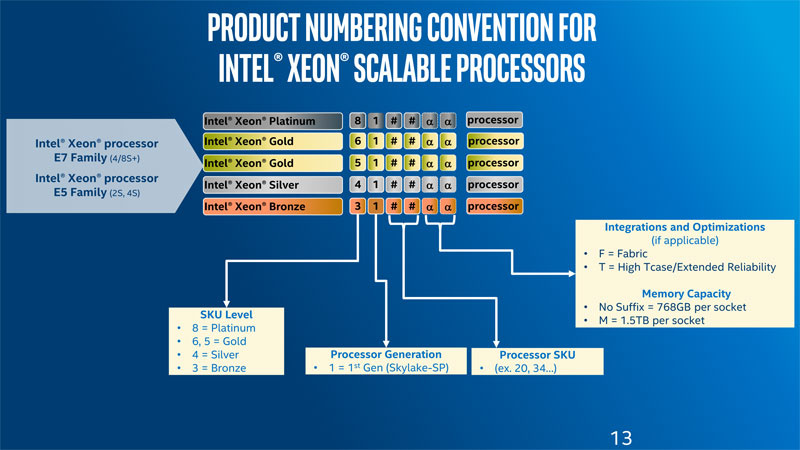What is Intel Xeon Scalable?

The upgrade of the Intel Xeon processor lineup this year has become the most significant event on the Intel server platform market since 2011, when the familiar E3, E5, E7 lines were released. And here again four-digit indices, in addition the Platinum series, Gold, Silver and Bronze, as well as the generalized Xeon Scalable brand. From the first attempt, it turned out to be difficult to understand the logic of what is happening, and in interested circles the question arose: why did it even need this? On the ideological background of creating a family of Xeon Scalable and the most interesting innovations in it, we will discuss in this post.
Faster, more compatible, more flexible
So, to begin with, the ideological aspect. In recent years, life in the family of Intel Xeon was knurled. Gradually clicked the generation counters, it happened asynchronously and randomly. Each line E3, E5, E7 lived its own life, in its socket, incompatible with its neighbors. Servers were designed for a specific line and only for it.
As time went on, E7 changed slowly, E3 quickly, but still significantly, a few years late in the Intel Core process technology. And unrealized potential is a lost profit. After analyzing the situation, Intel identified key problems that should be solved by the release of fundamentally new Xeon:
')
- the most rapid release of new Xeon after upgrading core Core,
- one-time update of the Xeon line across the width,
- socket compatibility for all Xeon Scalable.
What is the meaning of Scalable? In that, while observing the specified technological conditions (and a number of functional ones, which are discussed below), Xeon Scalable becomes a suitable basis for building a modern, well-scalable system. A change of generations will support the relevance of the system and its suitability for a constantly changing profile of loads, and compatibility with a socket will allow you to create a wide variety of “building blocks” of the desired performance and cost.
What areas most need complexes with similar characteristics? The most dynamic, such as cloud storage and services, software-defined systems, and so on. Well, what to do if servers are required for traditional workloads, say, for telecom (by the way, showing recently the negative growth dynamics of server capacity)? Then Xeon Scalable can be considered the next generation of Intel Xeon, Intel partners can easily provide you with advice on the compatibility of old and new lines.
New opportunities
Now about the functional innovations of Xeon Scalable - they also serve the purpose of turning the platform into a perfectly scalable node.
- Intel Volume Management Device (Intel VMD) . Fast services require fast storage. Intel VMD technology allows you to organize a set of different NVMe devices as a single logical storage and present it to consumers. Thus, for organizing network access to data on PCIe drives, additional devices are no longer required. Integration is a necessary condition for scalability.
- Intel Virtual RAID on CPU (Intel VROC) . Combined hardware and software solution that allows you to create RAID of various levels from PCIe drives.
- Built-in 4x10G Ethernet controller . According to Intel, a network interface with a total capacity of 40 Gbps will be sufficient to connect a single node. Again, according to the strategy, it should be embedded.
- Remote Direct Memory Access (RDMA) . For efficient clustering, a direct exchange of memory contents between applications on different nodes is necessary. The new Intel Ethernet Connection X722 network controllers support RDMA with the iWARP (Internet Wide-Area RDMA Protocol) extension, which allows data to be transmitted without additional copying and without using operating system cores.

Scalable and not only
Does the current reform mean that all Intel Xeon will now become Scalable? By no means. In general, the line will look like this:
- Xeon Scalable - successors to the Xeon E3 / E5 / E7. The correspondence table for clarity is given above. And yes, we still do not know why the 7000 series is missing
- Xeon D is a compact SoC for storage systems and telecom solutions, the line continues to evolve, new models will be presented later this year
- Xeon W (Workstation) - processors for high-end workstations, analogue to older Core, equipped with server functionality. Presented in Q3
- Xeon E (Essential) - to some extent the continuation of the current Xeon E3, entry-level server processors. The release date has not yet been announced.
So, the situation with the upgrade line of Intel Xeon has become more understandable. The new gradation reflects the desire of Intel to focus on the rapidly growing market segments and offer the best solution for them. All other consumers can consider it as a re-indexing, coupled with the change of generation, which brought certain functional improvements. To the new indices, I think, we all will soon get used to it - especially since they are, in general, well forgotten old ones.
Servers with Intel Scalable are available now. Here, for example, HP DL360 Gen10 . Note that if the previous generation DL360 was built only on Intel Xeon E5 processors (as befits a two-socket server), then now you have the entire set of lines from 3000 to 8000 (from Bronze to Platinum). That such scability is obtained.
Source: https://habr.com/ru/post/370791/
All Articles